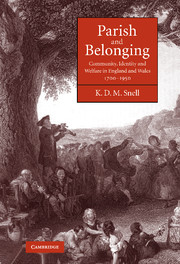Book contents
- Frontmatter
- Contents
- List of figures
- List of tables
- Preface and acknowledgements
- 1 Introduction – belonging and local attachment
- 2 The culture of local xenophobia
- 3 Settlement, parochial belonging and entitlement
- 4 Rural societies and their marriage patterns
- 5 ‘A cruel kindness’: parish out-door relief and the new poor law
- 6 Nailed to the church door? Parish overseers and the new poor law
- 7 Three centuries of new parishes
- 8 ‘Of this parish’: gravestones, belonging and local attachment
- 9 Conclusion – belonging, parish and community
- Select bibliography
- Subject and persons index
- Places index
9 - Conclusion – belonging, parish and community
Published online by Cambridge University Press: 27 July 2009
- Frontmatter
- Contents
- List of figures
- List of tables
- Preface and acknowledgements
- 1 Introduction – belonging and local attachment
- 2 The culture of local xenophobia
- 3 Settlement, parochial belonging and entitlement
- 4 Rural societies and their marriage patterns
- 5 ‘A cruel kindness’: parish out-door relief and the new poor law
- 6 Nailed to the church door? Parish overseers and the new poor law
- 7 Three centuries of new parishes
- 8 ‘Of this parish’: gravestones, belonging and local attachment
- 9 Conclusion – belonging, parish and community
- Select bibliography
- Subject and persons index
- Places index
Summary
This book has taken readers through a range of subjects relating to belonging and the parish in the past. It has covered the cultures of local xenophobia, the changing nature of the settlement laws, the decline of high parochial endogamy, the role of the parish and its overseers under the new poor law, the ‘new parishes’ and their problems, and how people showed their ideas of local belonging on their burial ground memorials. As I pointed out in the introduction and subsequently, ideas of ‘belonging’ are complex, subjective, culturally ingrained, based on different and often rival criteria, and intermeshed with administrative systems. They can be explored in a great variety of ways, and via many other themes than those chosen here. I am conscious of an enormity of possible themes. Some traverse the parish and take us into kinship and occupational regions beyond the parish, with their respective obligations and forms of mutuality. Many are addressed through important cultural variations involving ethnicity, language, dialect, religion, folklore and local calendars, collective actions, ritual and precedences, political dispositions, vernacular building and folk art. Others relate to senses of industrial community of the kinds established in countless textile, mining, shipbuilding, and other settlements associated with the Industrial Revolution.
It is obvious from these chapters that I do not believe that the word community should normally be put into inverted commas by historians speaking about the past, in the way of modern commentators who frequently search in vain for it now.
- Type
- Chapter
- Information
- Parish and BelongingCommunity, Identity and Welfare in England and Wales, 1700–1950, pp. 496 - 504Publisher: Cambridge University PressPrint publication year: 2006



